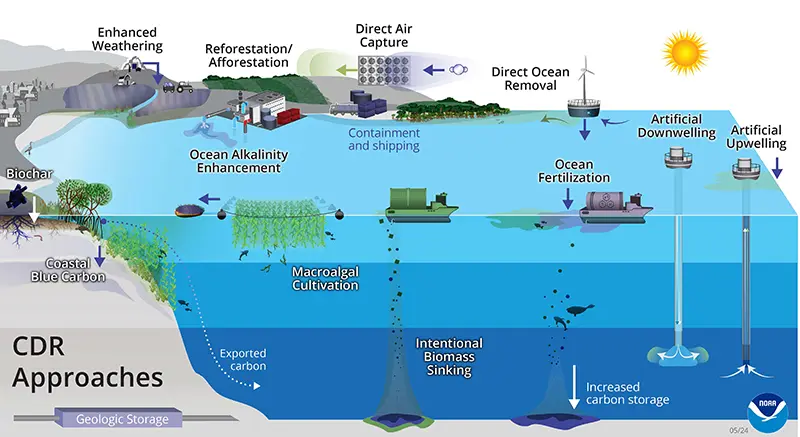Carbon Dioxide Removal Graphics GAllery
A collection of graphics from the NOAA Carbon Dioxide Removal Research Strategy that demonstrate various approaches of carbon dioxide removal
Approaches to Carbon Dioxide Removal
Approaches to carbon dioxide removal on land and sea. Carbon dioxide removal approaches are effective when they both remove a net positive amount of carbon dioxide from the atmosphere that would not otherwise have been removed without escaping back into the atmosphere for a long period of time (i.e. hundreds to thousands of years). Some of the approaches here rely on naturally occurring processes, while others are fully engineered.
File type: image/jpeg
File size: 331 KB
Dimensions: 2560 x 1398 pixels
Approaches to Marine Carbon Dioxide Removal
Approaches to marine, or ocean-based, carbon dioxide removal (mCDR). mCDR approaches are effective when they remove a net positive amount of carbon dioxide from the atmosphere that would not otherwise have been removed and they prevent that carbon from escaping back into the atmosphere for a long period of time (i.e. hundreds to thousands of years). Some of the approaches here rely on naturally occurring processes, while others are fully engineered.
File type: image/jpeg
File size: 434 KB
Dimensions: 2560 x 1398 pixels
Direct Air Capture
Direct air capture encompasses land-based processes that directly removes carbon dioxide from the air via filtration. Carbon dioxide is then transported to storage reservoirs in solid or liquid form where it is durably stored for hundreds to thousands of years. In some cases it is used for other purposes in a short-term manner.
File type: image/jpeg
File size: 258 KB
Dimensions: 2560 x 1403 pixels
Soil Carbon
Soil carbon sequestration is a process that removes carbon dioxide from the atmosphere and stores it in the soil, adding to the soil carbon pool. This process typically involves plant photosynthesis to absorb carbon. This carbon is stored long-term when it is mineralized, converted into bones or shells of animals, or converted into sugars used by microorganisms.
Microalgal Cultivation
The large-scale farming of seaweed, also known as macroalgal cultivation or aquaculture, draws down carbon dioxide from the atmosphere as part of the process of photosynthesis that occurs as the seaweed grows. The carbon is then stored when the biomass (vegetation) sinks to the ocean floor naturally or through intentional sinking, and becomes part of the sediment. Alternatively, seaweed can be used by harvesting and processing for food, fuel, fertilizer, or other uses. These activities would ultimately release carbon dioxide back to the atmosphere on a short timescale, and are therefore considered to be a form of carbon dioxide utilization, not carbon dioxide removal. Some of the carbon may also be released back into the atmosphere during farming.
File type: image/jpeg
File size: 243 KB
Dimensions: 2560 x 1403 pixels
Ocean Alkalinity Enhancement (Enhanced Weathering)
Ocean Alkalinity Enhancement through enhanced weathering can be done through spreading mined materials with high pH (alkaline) on land or in the ocean. This process can speed up the natural weathering of these alkaline materials, increasing the alkalinity of the ocean, resulting in the ocean to absorb more carbon dioxide from the atmosphere. Material that dissolves easily can be spread in solid or dissolved form directly over the ocean’s surface, while material that does not dissolve as easily must be spread in areas where chemical conditions or wave action speeds up the dissolution process.
Ocean Alkalinity Enhancement (Electrochemical Approaches)
Ocean Alkalinity Enhancement through electrochemical approaches involve using electric currents, via electrolysis or electrodialysis, to split seawater into an acid and a base. The base is then mixed with seawater and returned to the ocean, increasing the pH of seawater and causing it to absorb more carbon dioxide. The acid produced through this process must be disposed of, used in a responsible manner, or properly neutralized to prevent it from re-entering the ocean or causing harmful pollution on land.
File type: image/jpeg
File size: 272 KB
Dimensions: 2560 x 1403 pixels
Direct Ocean Capture
Direct Ocean Capture is the use of bipolar membrane electrodialysis to split seawater into base and acid. This is often done as an electrochemical method of ocean alkalinity enhancement. However, the basic solution can also be used to form carbonates, which locks up carbon dioxide in a solid form for storage on geologic timescales.
File type: image/jpeg
File size: 265 KB
Dimensions: 2560 x 1403 pixels
Ocean Fertilization
Ocean fertilization is the addition of nutrients such as iron, nitrogen, and phosphorus to the surface of the ocean to stimulate the growth of phytoplankton that naturally absorb carbon dioxide during photosynthesis. Phytoplankton are an important part of the marine food web; when they sink to the deep ocean floor either directly or as waste after being eaten by another marine animal, the carbon they hold is transferred into the deep sea which may be stable there for hundreds of years. Eventually the carbon may become sediment and be stable for geologic timescales (~1 million years).
File type: image/jpeg
File size: 210 KB
Dimensions: 2560 x 1403 pixels
Artificial Upwelling and Downwelling
Technological transport of cold, nutrient-rich water to the surface to stimulate primary production and increased export of carbon to depth (Artificial Upwelling, left) and CO2-rich water from the surface to depth where it can be sequestered (Artificial Downwelling, right). Note that artificial upwelling can bring naturally high-CO2, low-O2 waters to shallower depths where they may impact surface biological systems, or outgas CO2 back
to the atmosphere prior to the onset of high primary productivity resulting from nutrient additions. Additionally, these methods can be energy intensive, and are therefore often recommended to be deployed in conjunction with renewable marine energy sources.
File type: image/jpeg
File size: 246 KB
Dimensions: 2560 x 1403 pixels
Coastal Blue Carbon
File type: image/PNG
File size: 929 KB
Dimensions: 4259 x 2334 pixels
















